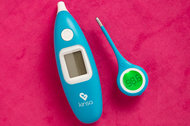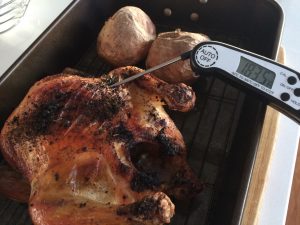Soon after Sorenne started at Junction Park State School, I started volunteering in the tuck shop, prepping foods for a few hundred kids on Fridays.
 I put in some time, but then politics overtook my food safety nerdiness so I stopped.
I put in some time, but then politics overtook my food safety nerdiness so I stopped.
But not before I left about 10 Comark tip-sensitive digital thermometers and advised, use them frequently.
While cooking breakfast this morning for 120 school kids, I ran into my friend, Dave, who is currently running the tuck shop, and he told me the thermometers get a regular workout each week, he had to change some batteries last week, and he took one home for cooking.
Now imagine that a tip-sensitive digital thermometer could be used to harness user data (and sell product).
Sapna Maheshwari of The New York Times writes that most of what we do — the websites we visit, the places we go, the TV shows we watch, the products we buy — has become fair game for advertisers. Now, thanks to internet-connected devices in the home like smart thermometers, ads we see may be determined by something even more personal: our health.
This flu season, Clorox paid to license information from Kinsa, a tech start-up that sells internet-connected thermometers that are a far cry from the kind once made with mercury and glass. The thermometers sync up with a smartphone app that allows consumers to track their fevers and symptoms, making it especially attractive to parents of young children.
The data showed Clorox which ZIP codes around the country had increases in fevers. The company then directed more ads to those areas, assuming that households there may be in the market for products like its disinfecting wipes. The Centers for Disease Control and Prevention recommends disinfecting surfaces to help prevent the flu or its spread.
Kinsa, a San Francisco company that has raised about $29 million from venture capitalists like Kleiner Perkins since it was founded in 2012, says its thermometers are in more than 500,000 American households. It has promoted the usefulness of its “illness data,” which it says is aggregated and contains no identifying personal information before being passed along to other companies.
 It is unique, Kinsa says, because it comes straight from someone’s household in real time. People don’t have to visit a doctor, search their symptoms on Google or post to Facebook about their fever for the company to know where a spike might be occurring.
It is unique, Kinsa says, because it comes straight from someone’s household in real time. People don’t have to visit a doctor, search their symptoms on Google or post to Facebook about their fever for the company to know where a spike might be occurring.
“The challenge with Google search or social media or mining any of those applications is you’re taking a proxy signal — you’re taking someone talking about illness rather than actual illness,” said Inder Singh, the founder and chief executive of Kinsa. Search queries and social media can also be complicated by news coverage of flu season, he said, while data from the C.D.C. is often delayed and comes from hospitals and clinics rather than homes.
The so-called internet of things is becoming enmeshed in many households, bringing with it a new level of convenience along with growing concerns about privacy.
Clorox used that information to increase digital ad spending to sicker areas and pull back in places that were healthier. Consumer interactions with Clorox’s disinfectant ads increased by 22 percent with the data, according to a Kinsa Insights case study that tracked performance between November 2017 and March of this year. That number was arrived at by measuring the number of times an ad was clicked on, the amount of time a person spent with the ad and other undisclosed metrics, according to Vikram Sarma, senior director of marketing in Clorox’s cleaning division.
 Being able to target ads in this way is a big shift from even seven years ago, when the onset of cold and cough season meant buying 12 weeks of national TV ads that “would be irrelevant for the majority of the population,” Mr. Sarma said. The flu ultimately reaches the whole country each year, but it typically breaks out heavily in one region first and then spreads slowly to others.
Being able to target ads in this way is a big shift from even seven years ago, when the onset of cold and cough season meant buying 12 weeks of national TV ads that “would be irrelevant for the majority of the population,” Mr. Sarma said. The flu ultimately reaches the whole country each year, but it typically breaks out heavily in one region first and then spreads slowly to others.
While social media offered new opportunities, there has been “a pretty big lag” between tweets about the flu or flulike symptoms and the aggregation of that data for marketers to use, he said.
“What this does is help us really target vulnerable populations where we have a clear signal about outbreaks,” Mr. Sarma said.
Imagine using similar for data for people cooking dinner tonight.
This is what we’re having (above, right; Chapman, about those thermometers?).












